How the German "Stalingrad fortress" was stormed
German "Stalingrad fortress"
On November 23, 1942, the troops of the Southwestern and Stalingrad fronts united in the Kalach region. In the resulting cauldron were 22 enemy divisions, numerous reinforcement units and RGK, which were part of the 6th field and 4th tank armies, the headquarters of the 4th, 8th, 11th, 51st army and 14th tank buildings.
After assessing the situation, General Paulus suggested that von Weichs, commander of Army Group B, immediately withdraw troops to the line of the Chir and Don rivers, restoring a solid front. The general noted that resistance in the environment is impossible. There are few forces, more than half of the front has no equipped positions, there is no forest for dugouts. Supply was inadequate even with land communications, and air supplies were even more limited. Commander Paulus offered an immediate breakthrough while the troops could still go for it.
General Weichs was of the same opinion. He was supported by the Chief of the General Staff of the Ground Forces, Zeitzler. The boiler did not have enough ammunition, fuel, provisions, winter uniforms.
But Hitler believed that it was impossible to retreat. The Fuhrer declared Stalingrad a "fortress" and the encircled troops a garrison. The 6th Army had to withstand the siege. Marshal Goering promised that the valiant Luftwaffe would provide the "fortress" with everything necessary.
As a result, Paulus did not dare to take responsibility and make a breakthrough. The army was ordered to hold out with all their might and wait for help. The Don army group was formed, which was supposed to release the army of Paulus and return the lost positions.
The breakthrough of the 6th Army itself, in conditions when the encirclement closed, was a risky undertaking with a dubious result. Under conditions of constant enemy pressure, shelling, throwing heavy weapon, when the fuel was running out, without enough ammunition, provisions, in winter in a snowstorm and snow - there was little chance.
Manstein himself noted:
It was clear that sooner or later the army, not supported by other German troops, would again be stopped by the enemy in the steppe, not having enough ammunition, fuel and food!
It is possible that individual units, especially tank units, could have escaped.
But the destruction of the 6th Army was a foregone conclusion!
The enemy forces bound by it so far would be released. This could lead to the destruction of the entire southern wing of the eastern front (including Army Group A, which was still in the Caucasus).
Thus, the German command and Manstein were ready to sacrifice the 6th Army so that it would divert the Russian forces. A convenient moment for the withdrawal of Paulus's army was missed, so the troops remained in Stalingrad, hoping for outside help.
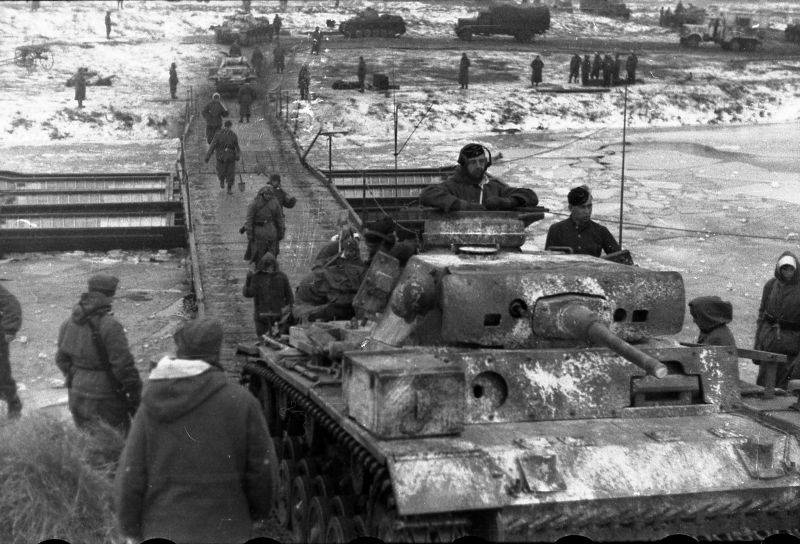
German tank Pz. Kpfw. III passes through a pontoon crossing near Stalingrad. December 1942
It was not possible to crush the 6th Army on the move
The Soviet command had to solve two difficult problems.
First, create a stable outer front of the encirclement and move it as far as possible to the west.
Secondly, quickly liquidate the 6th Army, freeing the troops.
Both tasks began to be solved without a pause on November 24, 1942. The idea was to strike in converging directions on Gumrak by the forces of the 21st, 65th, 24th, 66th, 62nd, 64th and 57th armies, reinforced by the 26th, 4th and 16th Panzer Corps and supported aviation 17th, 16th and 8th air armies (more than 1 vehicles), dismember the German army and destroy it.
For a week, Soviet troops on three fronts continuously attacked the Germans from all directions. Aviation made more than 6 thousand sorties. The morale of the troops was high. Soldiers and commanders were eager to crush the enemy. However, several days of stubborn fighting showed that the desire to win was not enough.
In particular, the command was still in a hurry and made mistakes. So, mobile formations were thrown head-on, to storm enemy positions, without conducting reconnaissance of the area, without breaking through the enemy’s defenses, without establishing interaction with infantry, artillery and aviation.
On the site of Galanin's 24th Army, Maslov's 24th Panzer Corps was thrown into the attack on the strong defense of the Germans on the morning of November 16. The interaction of infantry and tanks was not organized. Several tanks died in a minefield, others ran into enemy anti-tank artillery fire. The corps did not complete the task of capturing the crossings across the Don from Vertyachey. In the 57th army of the Stalingrad front, the 13th mechanized corps was similarly thrown into the attack. The mobile connection suffered heavy losses.
It was not possible to destroy the 6th German Army on the move. It became clear that a strong enemy cannot be broken with one blow. The commander of the Don Front Rokossovsky noted:
Careful preparation of a new offensive operation was required.
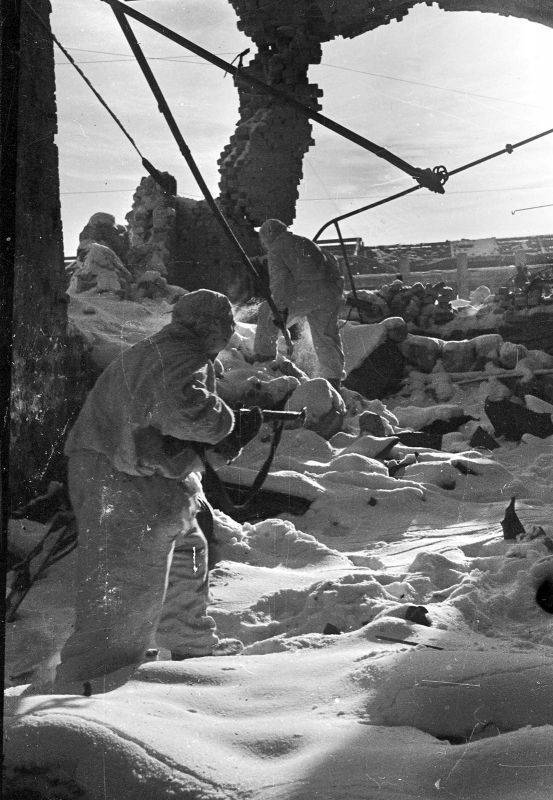
Soviet fighters in winter camouflage suits are searching for the enemy in the destroyed workshop of the plant in Stalingrad. 1942–1943
By November 30, 1942, the encirclement ring had been halved, but not split.
The command of the 6th Army withdrew troops from the small bend of the Don and strengthened their positions to the west of the Rossoshka River. Paulus shortened the front line, condensed battle formations, organized combat units and subunits from various rear services, signalmen, staff officers, etc.
The Germans skillfully maneuvered their reserves inside their internal front: 30–40 km long from north to south and 70–80 km from west to east. In the center, in the area of Pitomnik and Gumrak, there were airfields inaccessible to Soviet artillery. The German Air Force created an air bridge.
The Nazis skillfully used the Stalingrad defense system created by the Soviet troops (in the summer of 1942). Settlements were turned into nodes of resistance, heights were fortified, railway embankments were adapted for defense, tanks, steam locomotives and wagons that were out of action were used as firing points.
As a result, a strong “fortress”, a fortified area, was created. The soldiers of the Wehrmacht, believing in the help promised by the Fuhrer, despite the cold, the reduction in rations, fought skillfully and steadfastly.
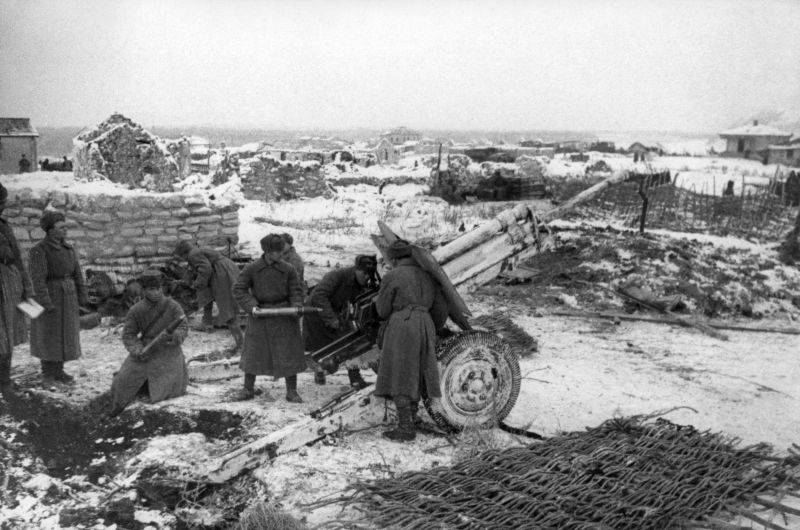
Soviet artillerymen firing from a 76,2 mm divisional gun mod. 1939 near Stalingrad. November 1942
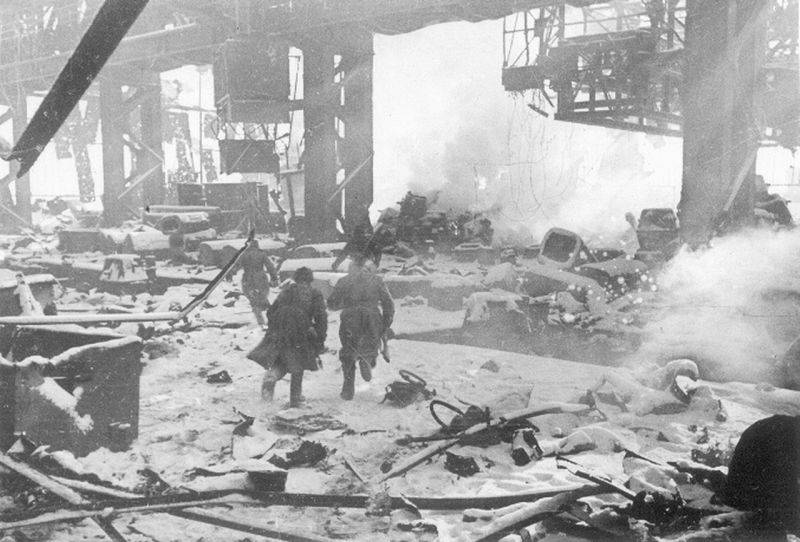
Fight in one of the shops of the plant "Red October". December 1942
December. Underestimation of the enemy
In the first ten days of December, at the request of the Headquarters, a new attempt was made to destroy the Stalingrad enemy grouping. But unsuccessfully.
Firstly, Stalingrad was liberated by two fronts - Stalingrad (Eremenko) and Don (Rokossovsky). There was no unified leadership, which led to poor organization. The armies of the two fronts advanced at different times, the Germans could maneuver their reserves.
Secondly, the enemy was still seriously underestimated. It was believed that there were about 85 thousand people in the boiler. In fact, the Stalingrad grouping of Paulus numbered about 220 thousand people, 3 guns and mortars, 200 tanks.
As of December 1, 1942, the Stalingrad and Don Fronts included 480 thousand people, more than 8,4 thousand guns and mortars, and more than 450 tanks.
Therefore, they decided to reinforce the Don Front with the Headquarters reserve - the 2nd Guards Army, which included selected formations - the 1st and 13th Guards Rifle Corps, the 2nd Guards Mechanized Corps. A new operation was being prepared to defeat the 6th Army. The start of the offensive was scheduled for 18 December.
However, on December 12, the German operation “Winter Thunderstorm” began - the 57th tank corps of the Goth group began to break through from Kotelnikovo to Stalingrad. In five days, the Nazis advanced 75 km. Three tank divisions (about 500 tanks and self-propelled guns) pierced the corridor along which they planned to supply the Stalingrad fortress with a steel ram.
Hitler did not plan to withdraw Paulus's army from the city. Therefore, the 2nd Guards Army was thrown into the Kotelnikovsky direction.
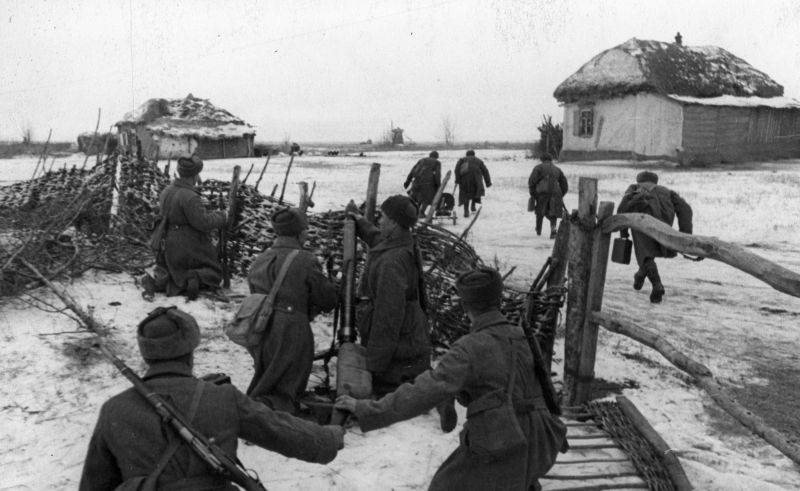
Calculation of the Soviet 82-mm mortar arr. 1941 covers advancing machine gunners northwest of Stalingrad. December 1942
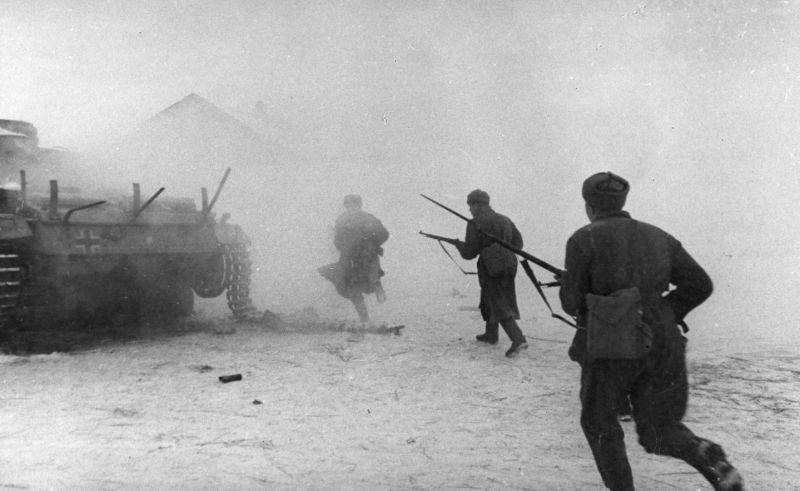
Red Army soldiers run past a wrecked German tank Pz. Kpfw. III in the attack near Stalingrad. November-December 1942
Manstein's attempt to break through to Stalingrad was repulsed.
Gotha's group, having lost 230 tanks, began to withdraw. However, Operation Ring to defeat the 6th Army had to be postponed for a month. At the same time, frequent operations continued at that time, the divisions launched attacks, exhausted the enemy, depleted his ammunition. They improved positions, slowly pushed back the Nazis, reducing its territory. The Germans responded, counterattacked, trying to maintain their positions and recapture what they had lost.
The consumption of shells had no analogues in the world.
The average monthly consumption of ammunition in the Stalingrad offensive operation was 3 million shells and mines, more than 90 million cartridges for small arms - 64 wagons per day. Long-range aviation formations and three air armies attacked enemy airfields in the ring itself and behind the outer front of the encirclement. An air defense division and almost 400 anti-aircraft guns guarded enemy transports.
It was decided to entrust the final defeat of the German Stalingrad group to Rokossovsky. On December 30, the 62nd, 64th and 57th armies of the Stalingrad Front were transferred to the Don Front.
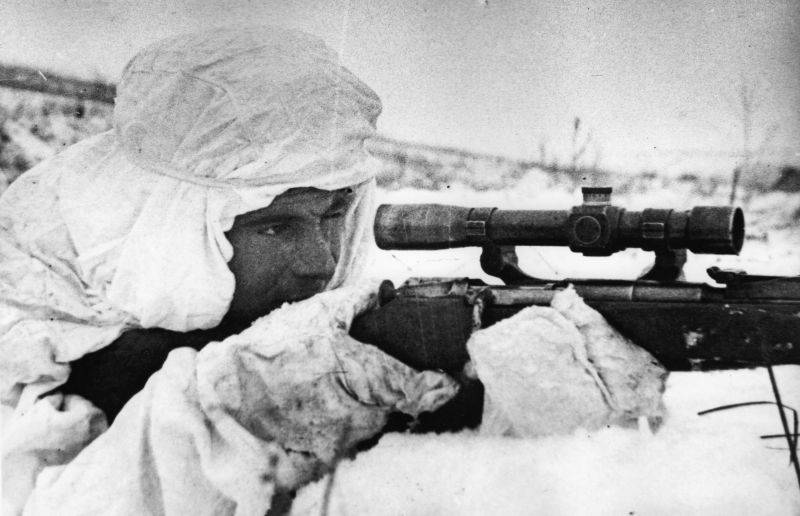
Sniper of the 117th Infantry Regiment of the 23rd Infantry Division of the 21st Army of the Don Front Alexander Frolov in position near Stalingrad. Alexander Ivanovich Frolov (07.03.1924/04.10.1978/1941 - 1942/20/1942) was drafted into the Red Army in August 10, on the fronts since 1942. As part of his regiment, he fought on the North-Western, Stalingrad, Don fronts. Wounded 117 February 92. During the Battle of Stalingrad he was one of the best snipers. On October 4, 4, a sniper of the 2th Infantry Regiment (of the same division), Corporal A. I. Frolov, was presented by the command of the unit for a new award for the destruction of 1 Nazis (of which: 6 officers and 1 snipers). In addition, armor-piercing incendiary bullets knocked out 272 machine guns and 44 light machine gun. By that time, he trained 5 fighters in sniper business, who destroyed 1942 fascists in just 18 month. By Order No. 1943/n dated November 143, 6, he was awarded the Order of the Red Banner for the troops of the Don Front. On February 105, 31, junior lieutenant A.I. Frolov was presented by the command of the unit to the title of Hero of the Soviet Union for the destruction of 1943 enemy soldiers and officers, 21 machine guns and the training of a large group of young snipers. And by order No. XNUMX / n dated March XNUMX, XNUMX, he was awarded the second Order of the Red Banner for the troops of the XNUMXst Army. Came to Germany.
Operation "Ring"
On January 4, 1943, the operation plan was approved. It provided for a cutting blow from west to east by the forces of the 65th Army (10 rifle, 2 artillery divisions, a tank brigade).
At the first stage, the army was to advance southeast to Novy Rogachik and, in cooperation with the 21st Army (7 rifle divisions, one heavy artillery division, a tank brigade) and strike groups of the 64th and 57th armies, destroy the Nazis who were defending west of the river Rossoshki. More than a quarter of the artillery forces of the front (65 artillery regiments, including 36 high power, 2 anti-aircraft and 5 regiments of rocket launchers) were concentrated on the sector of the 5th Army. The main forces of the 16th Air Army acted in the interests of Batov's army. The left flank of the 65th Army was supported by Galanin's 24th Army (6 divisions).
At the second stage of the operation, the main blow was going to be delivered to the zone of the 21st Army, which, in cooperation with the 65th, 57th and 64th armies, was to develop an offensive on Voroponovo.
At the third stage - a general decisive assault.
From the reserve of the Headquarters of the Supreme High Command, the front was reinforced with another artillery division, two regiments and a division of high-powered artillery, 5 anti-tank regiments, 2 rocket artillery divisions, one anti-aircraft artillery regiment, 7 breakthrough guard tank regiments. March replenishment arrived - 20 thousand people.
In total, by the beginning of the operation, the Don Front consisted of 39 rifle divisions, 10 rifle, motorized rifle and naval brigades, 7 air divisions, 45 mortar and artillery regiments of the RKG, 10 rocket artillery regiments, 17 air defense artillery regiments, 5 tank brigades and 14 tank regiments. The density of artillery in the main direction was 220 guns and mortars per kilometer of the front.
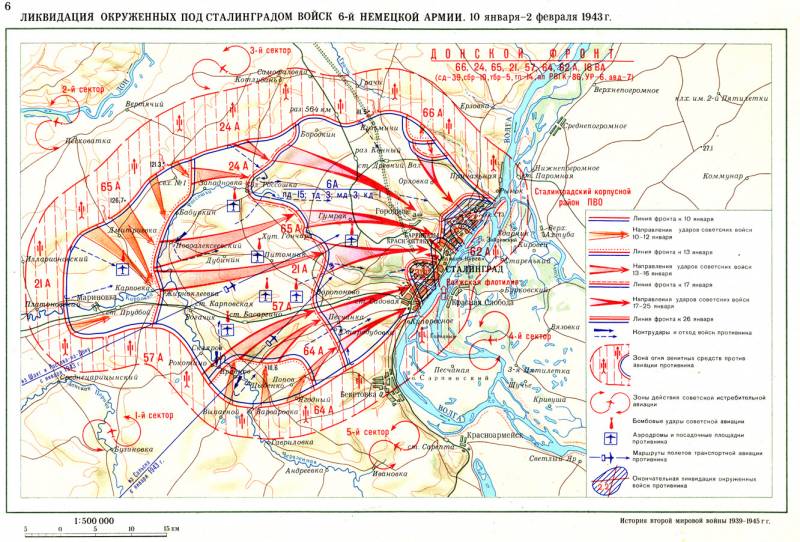
The 65th army of Batov and the 21st army of Chistyakov were opposed by the 384th and 44th infantry, 29th and 3rd motorized divisions of the enemy. The German divisions were already bled dry. So, in the 3rd motorized division there were 25 tanks, 36 guns and 80 active fighters in each of the 6 battalions. The reserve of the division consisted of a sapper battalion (150 people). Most of the tanks, due to the lack of fuel, were turned into fixed firing points.
On January 8, the Germans were offered to surrender.
The Germans did not answer. The Fuhrer forbade surrender. The command of the 6th Army carried out the task of pinning down the Russian armies, which gave the high command the opportunity to reorganize the southern flank of the Eastern Front.
At the first interrogation, Paulus said that he did not lay down his arms, as this was required by the strategic calculations of the rate. Hitler also promised that by mid-February a powerful deblocking blow would follow, which would change the situation at the front. For this, they planned to use the troops that were withdrawn from the Caucasus, and the SS tank corps that had begun redeploying from France.
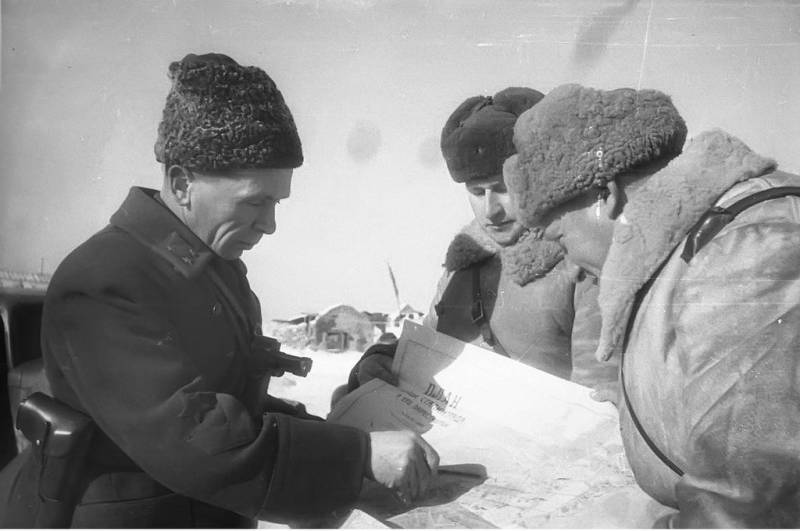
Commander of the 65th Army of the Don Front, Lieutenant-General P.I. Batov with officers in the Stalingrad region. Winter 1942–1943
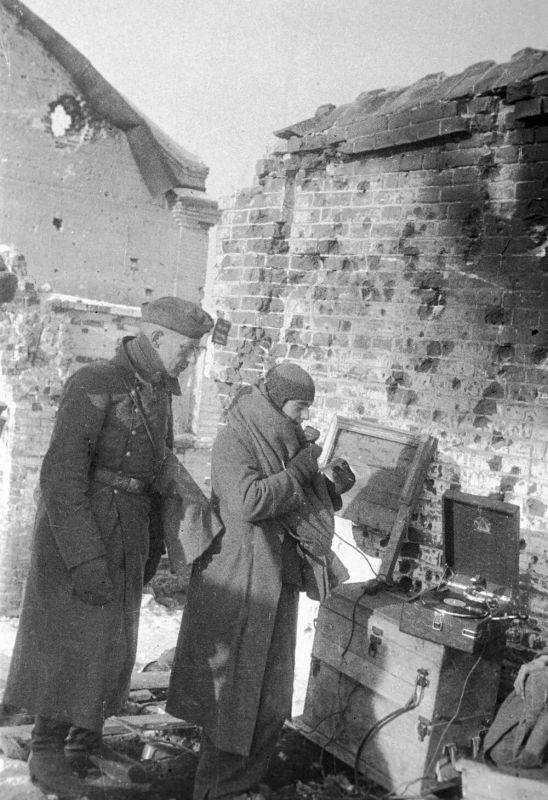
Captured soldiers of the Wehrmacht record an appeal (or broadcast it on the radio) to their comrades fighting in Stalingrad. January 1943
To be continued ...
- Alexander Samsonov
- https://ru.wikipedia.org/, http://waralbum.ru/
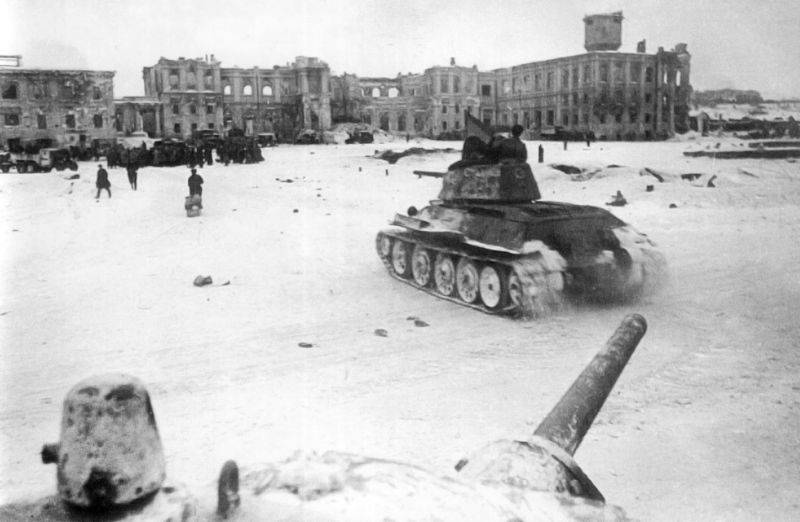
Information